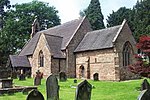Brewood Grammar School

Brewood Grammar School was a boys' school in the village of Brewood in South Staffordshire, England. Founded in the mid 15th century by the Bishop of Lichfield as a chantry school it was closed by the Dissolution of Chantries Act 1547. It was re-founded by Matthew Knightley and Sir Thomas Gifford in 1553 and survived as a grammar school until 1975 when its last headmaster, Roy Leafe, retired. It then became a mixed-sex middle school in 1977. As a 20th-century grammar school it took a number of boarders who lived at Wheaton Aston Hall, and taught agricultural science. The school had a small attached farm with cattle and poultry. The original building does not survive. The earliest part of the remaining buildings, originally two houses donated to the school, dates from 1778. In 1799 these were enclosed in the school grounds by moving the road. They were rebuilt in 1856 as Rushall House (now Grade II listed) and used as a schoolroom and dormitories. In 1863 the headmaster's house was rebuilt, and further extensions to the school were made in 1898, 1926, 1935, and 1952. The school is commemorated in a recent memorial window in the nearby parish church, St Mary and St Chad.
Excerpt from the Wikipedia article Brewood Grammar School (License: CC BY-SA 3.0, Authors, Images).Brewood Grammar School
School Road, South Staffordshire Brewood and Coven
Geographical coordinates (GPS) Address Website Nearby Places Show on map
Geographical coordinates (GPS)
| Latitude | Longitude |
|---|---|
| N 52.6757 ° | E -2.1759 ° |
Address
Brewood CE Middle Academy
School Road
ST19 9DS South Staffordshire, Brewood and Coven
England, United Kingdom
Open on Google Maps









